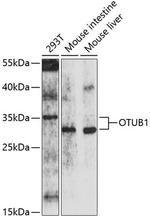Search Thermo Fisher Scientific
FIGURE: 1 / 1
OTUB1 Antibody (PA5-120082) in WB

Product Details
PA5-120082
Species Reactivity
Host/Isotype
Class
Type
Immunogen
Conjugate
Form
Concentration
Purification
Storage buffer
Contains
Storage conditions
Shipping conditions
RRID
Product Specific Information
Positive test controls include: 293T, Mouse intestine, Mouse liver. The target is usually found in the following locations: Cytoplasm.
Immunogen sequence: ERLELSVLYK EYAEDDNIYQ QKIKDLHKKY SYIRKTRPDG NCFYRAFGFS HLEALLDDSK ELQRFKAVSA KSKEDLVSQG FTEFTIEDFH NTFMDLIEQV E
Target Information
The product of this gene is a member of the OTU superfamily of predicted cysteine proteases. The encoded protein is a highly specific ubiquitin iso-peptidase, and cleaves ubiquitin from branched poly-ubiquitin chains but not from ubiquitinated substrates. It interacts with another ubiquitin protease and an E3 ubiquitin ligase that inhibits cytokine gene transcription in the immune system. It is proposed to function in specific ubiquitin-dependent pathways, possibly by providing an editing function for polyubiquitin chain growth. Alternative splicing results in multiple transcript variants.
For Research Use Only. Not for use in diagnostic procedures. Not for resale without express authorization.
References (0)
Bioinformatics
Protein Aliases: Deubiquitinating enzyme OTUB1; FLJ20113; FLJ40710; hOTU1; MGC111158; MGC4584; OTU domain, ubiquitin aldehyde binding 1; OTU domain-containing ubiquitin aldehyde-binding protein 1; OTU-domain Ubal-binding 1; otubain 1; Otubain-1; Ubiquitin thioesterase OTUB1; ubiquitin-specific protease otubain 1; Ubiquitin-specific-processing protease OTUB1
Gene Aliases: AI850305; HSPC263; OTB1; OTU1; OTUB1
UniProt ID: (Human) Q96FW1, (Mouse) Q7TQI3
Entrez Gene ID: (Human) 55611, (Mouse) 107260

Performance Guarantee
If an Invitrogen™ antibody doesn't perform as described on our website or datasheet,we'll replace the product at no cost to you, or provide you with a credit for a future purchase.*
Learn more
We're here to help
Get expert recommendations for common problems or connect directly with an on staff expert for technical assistance related to applications, equipment and general product use.
Contact tech support
